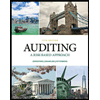
Concept explainers
(a)
Account:
An account refers to a financial record in the general ledger, where the increase or decrease in the values of the assets, liabilities, stockholder’s equity, revenues or expenditures of the business, pertaining to a particular period are recorded. Some of the accounts are assets, liabilities, and stockholder’s equity.
Assets:
Assets are the resources, owned by the company, that are used for the generation of income in the future. Assets are classified under four major heads which are as follows:
- Current assets
- Long-term investments
- Property, Plant and Equipment
- Intangible assets
Some of the examples of assets are equipment,
Liabilities:
Liabilities refer to the financial debts or obligations, which the company is owed to its creditors. The creditors have the claims over the assets of the company. Some of the examples of the liabilities are accounts payable, unearned revenue, and income tax payable.
Stockholder’s equity represents the capital contributed by the shareholders to its business and the revenues generated for the business. Stockholders’ equity is sometimes referred to as the net worth of the shareholders or stockholders. The two parts of stockholders’ equity are common stock and
Normal debit and credit balance:
The excess amount of debit side over the credit side is shown as the normal debit balance. The excess amount of credit side over the debit side is shown as the normal credit balance.
| Type of account | Normal balance |
| Assets account | Debit balance |
| Liabilities account | Credit balance |
| Expense account | Debit balance |
| Revenue account | Credit balance |
| Dividends account | Debit balance |
Table (1)
To indicate: whethereach of the following account is an asset, a liability, or a stockholder’s equity account and whether it would have a normal debit or credit balance.
(b)
To indicate: whethereach of the following account is an asset, a liability, or a stockholder’s equity account and whether it would have a normal debit or credit balance.
(c)
To indicate: whethereach of the following account is an asset, a liability, or a stockholder’s equity account and whether it would have a normal debit or credit balance.
(d)
To indicate: whethereach of the following account is an asset, a liability, or a stockholder’s equity account and whether it would have a normal debit or credit balance.
(e)
To indicate: whethereach of the following account is an asset, a liability, or a stockholder’s equity account and whether it would have a normal debit or credit balance.
Want to see the full answer?
Check out a sample textbook solution
Chapter 3 Solutions
FINANCIAL ACCOUNTING LOOSELEAF
- The Ivam Department transferred 6,000 units to the finished goods storeroom for a month. There was no beginning work in process inventory, but 800 units were still in process at the end of the month and were 70% complete, and production costs incurred totaled $21,320. Inventory costs would be determined using a unit cost of $____. a. $3.55. b.$3.42. c. $3.25. d. $3.14.arrow_forwardEquipment with a cost of $1,912,000 has an estimated salvage value of $52,000 and an estimated life of 4 years or 47,000 hours. It is to be depreciated using the units-of-activity method. What is the amount of depreciation for the first full year, during which the equipment was used for 9,200 hours?arrow_forwardRight answerarrow_forward
- Principles of Accounting Volume 1AccountingISBN:9781947172685Author:OpenStaxPublisher:OpenStax College
 Intermediate Accounting: Reporting And AnalysisAccountingISBN:9781337788281Author:James M. Wahlen, Jefferson P. Jones, Donald PagachPublisher:Cengage Learning
Intermediate Accounting: Reporting And AnalysisAccountingISBN:9781337788281Author:James M. Wahlen, Jefferson P. Jones, Donald PagachPublisher:Cengage Learning College Accounting, Chapters 1-27AccountingISBN:9781337794756Author:HEINTZ, James A.Publisher:Cengage Learning,
College Accounting, Chapters 1-27AccountingISBN:9781337794756Author:HEINTZ, James A.Publisher:Cengage Learning,  Auditing: A Risk Based-Approach (MindTap Course L...AccountingISBN:9781337619455Author:Karla M Johnstone, Audrey A. Gramling, Larry E. RittenbergPublisher:Cengage Learning
Auditing: A Risk Based-Approach (MindTap Course L...AccountingISBN:9781337619455Author:Karla M Johnstone, Audrey A. Gramling, Larry E. RittenbergPublisher:Cengage Learning College Accounting (Book Only): A Career ApproachAccountingISBN:9781337280570Author:Scott, Cathy J.Publisher:South-Western College Pub
College Accounting (Book Only): A Career ApproachAccountingISBN:9781337280570Author:Scott, Cathy J.Publisher:South-Western College Pub




